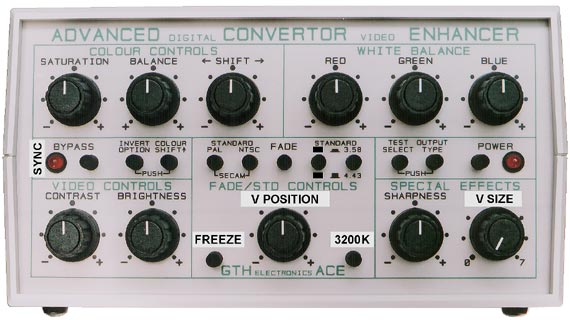

The following descriptions explain the main purpose of each control and there is also a 'Useful Tips' section in the Instruction Manual where some interesting and useful combinations are suggested. Please see the Performance and Specifications page for full technical details of performance and connections.
Click on any Control Group in the Picture Above to go Directly to its Description.
| Format | Version | Fields | Colour | STANDARD | STANDARD | ||
| PAL | NTSC | 60 | 3.58 | ||||
| PAL | Slow PAL | 48Hz | 4.43MHz | IN | OUT | OUT | OUT |
| Slow PAL | 48Hz | 3.58MHz | IN | OUT | OUT | IN | |
| NTSC | Slow NTSC | 48Hz | 3.58MHz | OUT | IN | OUT | IN |
| Slow NTSC | 48Hz | 4.43MHz | OUT | IN | OUT | OUT | |
| SECAM | Slo SECAM | 48Hz | 4MHz FM | IN | IN | Any Position | |
FADE: This button initiates an Automatic Fade in about 1 second. Pressing it IN will cause the picture to fade to black. Releasing the button to OUT will cause the picture to be restored by a reverse fade.
FREEZE: When Pressed IN this button holds the last two fields captured. By default these two fields are averaged and the result displayed for both output fields to avoid motion flicker. However the INVERT OPTION button allows you to cycle through four display modes: Both Fields Averaged & Repeated / Both Fields Displayed in sequence / Field 1 Repeated / Field 2 Repeated. We suggest you simply select a mode by eye for the best results, noting that when both input fields are shown in sequence there may be motion jitter. This changes to a static motion blur when both fields are averaged.
3200K: When Pressed IN this button selects a fixed colour correction to convert the normal TV colour temperature of around 5500K to 3200K. White Balance controls are disabled.
V POSITION: This is used in conjunction with the V SIZE control and adjusts the vertical position over the full TV screen height when image size has been reduced. This will help compensate for vertical positioning errors when NTSC or PAL TVs are used with 48Hz scanning when they are likely to overscan.
BALANCE: This control alters the colour balance of coloured areas
without affecting white balance and is especially
useful for correcting any residual faults in skin tone when white
balance has been corrected. This is important as White Balance alone
does NOT cure All colour faults. The ACEs are unique in offering both.
NOTE: When the video input source is NTSC this control automatically
acts as a HUE control.
<-SHIFT->: After recording and video processing you will often
find that the colour seems to 'bleed' out of
the coloured areas. This is caused by faults in the video processing which
can move the colour sideways compared to the black and white parts of the
picture and is particularly evident with multiple generation copies. This
control allows the colour part of the picture to be moved horizontally
left and right to line up the colour properly and eliminate the colour
bleed.
Vertical Colour Shift is provided by the COLOUR SHIFT
^ Control to cure colour droop.
V SIZE: This is the only rotary control which should normally be set nearly fully clockwise at about the 3 o'clock position (6th step out of 7) as this is the position in which it has no effect on the picture height. At the minimum setting the image height will be reduced by 3/4. This is intended to compensate for overscanning of TVs when operated at 48Hz. The V SIZE control will allow the image to be expanded vertically in 6 steps of 5.5% back up to full height and at the 7th position to overscan. When the V SIZE control is set below position 6 of the possible 7 steps the V POSITION control can be used to move the image vertically over the available output height range to allow images to be correctly centred.
INVERT OPTION: Pressing this button allows you to cycle through the options in order: Normal / Negative / Colour Invert / Video Invert. In Negative Mode it is possible to view colour negatives, assuming you have a slide converter and film strip holder or can improvise. With Colour Inverted, green turns into purple, blue into yellow and skin tone a ghastly blue colour. Ideal to turn people into monsters! With Video Inverted, black parts of the picture go white and vice-versa. With Normal Colour this can have a quite pleasing but spooky effect. NOTE: This becomes the Display Mode control in Freeze Frame and on the "M" Special Version in non-freeze frame mode it controls Left/Right Mirror Imaging. (See Special Versions Page)
COLOUR SHIFT ^: Pressing this button allows you to cycle through the Vertical Colour Shift range of 0 to +3 lines and back to 0, to get rid of 'colour droop' often resulting after several generations of copying.
OUTPUT TYPE: Pressing this button allows you to cycle through 4 output combinations on the "S" Video Output & SCART Connectors, allowing access to "S" or Dual Composite Video on the "S" Output Socket and to RGB or YUV on the SCART Socket.
POWER: The operation of this button will come as no surprise. It must be IN for normal operation!
Copyright GTH Electronics 1997 - 2025
Click Here to Return to the
GTH Home Page
| Email to: sales@gthelectronics.com | Telephone: 01692 402501 | International Tel: +44 1692 402501 |